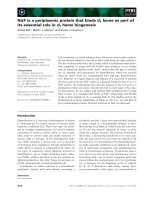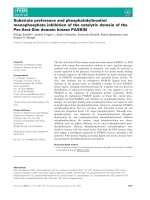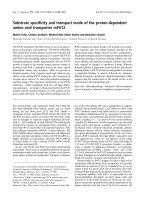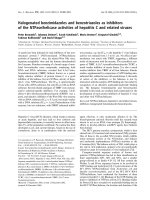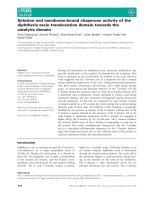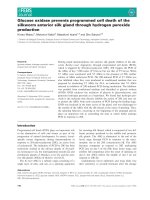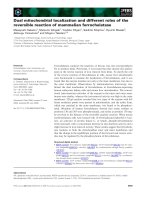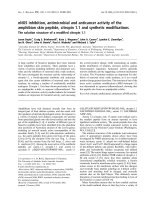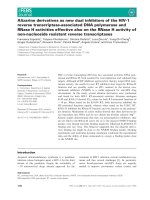Báo cáo khoa học: LIN54 is an essential core subunit of the DREAM / LINC complex that binds to the cdc2 promoter in a sequence-specific manner ppt
Bạn đang xem bản rút gọn của tài liệu. Xem và tải ngay bản đầy đủ của tài liệu tại đây (736.08 KB, 14 trang )
LIN54 is an essential core subunit of the DREAM / LINC
complex that binds to the cdc2 promoter in a
sequence-specific manner
Fabienne Schmit, Sarah Cremer and Stefan Gaubatz
Department of Physiological Chemistry I, Biocenter, University of Wuerzburg, Germany
Introduction
The retinoblastoma tumor suppressor protein (pRB)
and the related pocket proteins (p107 and p130) func-
tion together with E2F transcription factors to regulate
the cell cycle, differentiation and development [1]. The
activity of the pocket proteins is regulated by cyclin-
dependent kinases which phosphorylate the pocket
proteins and thereby release E2F, which then further
transcriptionally activates cyclins and other cell cycle-
dependent genes [2].
We and others have recently identified a new E2F–
pocket protein complex in mammalian cells that plays
an important role in gene repression in quiescent cells
and in the activation of mitotic genes [3–5]. This com-
plex, called LINC or human DREAM, consists of a
five-protein core module that dynamically associates
with p130 and the E2F4 and B-MYB transcription fac-
tors in a cell cycle-dependent manner. LINC has been
highly conserved throughout evolution. A similar
Keywords
cell cycle; CXC; DNA binding; LIN54;
LINC/DREAM
Correspondence
S. Gaubatz, Department of Physiological
Chemistry I, Biocenter, University of
Wuerzburg, 97074 Wuerzburg, Germany
Fax: +49 931 3184150
Tel: +49 931 3184138
E-mail: stefan.gaubatz@biozentrum.
uni-wuerzburg.de
(Received 4 June 2009, revised 23 July
2009, accepted 5 August 2009)
doi:10.1111/j.1742-4658.2009.07261.x
Recently, the conserved human LINC ⁄ DREAM complex has been
described as an important regulator of cell cycle genes. LINC consists of a
core module that dynamically associates with E2F transcription factors,
p130 and the B-MYB transcription factor in a cell cycle-dependent manner.
In this study, we analyzed the evolutionary conserved LIN54 subunit of
LINC. We found that LIN54 is required for cell cycle progression. Protein
interaction studies demonstrated that a predicted helix–coil–helix motif is
required for the interaction of LIN54 with p130 and B-MYB. In addition,
we found that the cysteine-rich CXC domain of LIN54 is a novel DNA-
binding domain that binds to the cdc2 promoter in a sequence-specific
manner. We identified two binding sites for LIN54 in the cdc2 promoter,
one of which overlaps with the cell cycle homology region at the transcrip-
tional start site. Gel shift assays suggested that, in quiescent cells, the bind-
ing of LIN54 at the cell cycle homology region is stabilized by the binding
of E2F4 to the adjacent cell cycle-dependent element. Our data demon-
strate that LIN54 is an important and integral subunit of LINC.
Structured digital abstract
l
MINT-7239362: LIN54 (uniprotkb:Q6MZP7) physically interacts (MI:0915) with p130
(uniprotkb:
Q08999)byanti tag coimmunoprecipitation (MI:0007)
l
MINT-7239376: LIN54 (uniprotkb:Q6MZP7) physically interacts (MI:0915) with B-Myb
(uniprotkb:
P10244)byanti tag coimmunoprecipitation (MI:0007)
Abbreviations
BrdU, bromodeoxyuridine; CDE, cell cycle-dependent element; CHR, cell cycle homology region; pRB, retinoblastoma tumor-suppressor
protein; shRNA, small hairpin RNA.
FEBS Journal 276 (2009) 5703–5716 ª 2009 The Authors Journal compilation ª 2009 FEBS 5703
complex, called DREAM or MMB, was first identified
in Drosophila [6,7]. The Caenorhabditis elegans homo-
logs of DREAM and LINC form the highly related
DRM complex that mainly acts in the repression of
developmental genes [8].
Unlike the Drosophila and C. elegans complexes, the
composition of human LINC is regulated during the
cell cycle. Specifically, in quiescent cells, LINC inter-
acts with p130 and E2F4 and contributes to the repres-
sion of E2F target genes [3,5,9]. The binding of LINC
with E2F4 ⁄ p130 is disrupted in the S phase. At this
time, B-MYB, a member of the vertebrate MYB fam-
ily, is incorporated into the complex. LINC–B-MYB
binds to and activates the promoters of G2⁄ M genes
[4,10,11]. One particular well-studied subunit of LINC
is the LIN9 protein. LIN9 depletion in human and
mouse cells leads to reduced activation of G2 ⁄ M target
genes and cell cycle inhibition [9]. LIN9 also plays a
role in zebrafish development and in transcriptional
regulation in response to DNA damage [12,13].
Another conserved core subunit of LINC is LIN54.
LIN54 homologs are present in many species, includ-
ing plants (Arabidopsis thaliana), invertebrates (C. ele-
gans and Drosophila melanogaster) and humans, who,
in addition to LIN54, express a testis-specific homolog,
tesmin [14–18]. LIN54 homologs contain dual cysteine-
rich domains, termed CXC, with the consensus
sequence CXCX
4
CX
3
YCXCX
6
CX
3
CXCX
2
C. The two
CXC domains are separated by a short spacer. It is
possible, yet unproven, that the dual CXC domain of
LIN54 functions as a DNA-binding domain.
In this study, we investigated the function of LIN54.
We found that LIN54 is required for the proliferation
of human cells. Using LIN54 deletion mutant con-
structs, we demonstrated that a conserved helix–coil–
helix (HCH) region is essential for the binding of
LIN54 to p130 and B-MYB. We also found that the
dual CXC domain of LIN54 is a DNA-binding
domain that binds to the cdc2 promoter in a sequence-
specific manner. We identified two binding sites for
LIN54 in the cdc2 promoter, one of which overlaps
with the cell cycle homology region (CHR) at the tran-
scriptional start site. Our data suggest that, in quies-
cent cells, the binding of LIN54 at CHR is stabilized
by E2F4 bound to the adjacent cell cycle-dependent
element (CDE). Taken together, these data establish
LIN54 as an essential member of the LINC ⁄ DREAM
complex.
Results
We have shown previously that the depletion of LIN9
in human cells inhibits proliferation and results in
delayed entry into mitosis [9]. To address whether this
is an isolated function of LIN9 or whether it is medi-
ated by LINC, we examined another subunit of LINC,
LIN54. Immortalized BJ cells containing the ecotroph-
ic receptor (BJ-ET) were infected with a retrovirus
encoding a small hairpin RNA (shRNA) against
LIN54, or with a control retrovirus. The efficiency of
LIN54 depletion was tested at the mRNA and protein
level. LIN54 mRNA was reduced by 70% and a signif-
icant reduction in the protein level was detected in
immunoblots in cells infected with the LIN54-specific
shRNA (Fig. 1A, B).
Next, the proliferation of LIN54-depleted cells com-
pared with control cells was analyzed. When LIN54-
depleted cells were monitored for 12 days in culture,
we found that they grew significantly more slowly than
control cells, indicating that LIN54 is required for the
proliferation of human cells (Fig. 1C). To better char-
acterize the cell cycle defects, flow cytometry profiles
of control cells and LIN54-depleted BJ-ET cells were
compared. Cells were labeled with bromodeoxyuridine
(BrdU) to identify the population of cells in S phase.
As shown in Fig. 2A, LIN54 depletion results in an
accumulation of cells in G2 ⁄ M and in a reduction in
the fraction of cells in S phase. Staining with an anti-
body against phosphorylated histone H3 revealed a
decrease in the percentage of mitotic cells in LIN54-
depleted cells compared with control cells (Fig. 2B).
Together with the fluorescence-activated cell sorting
data, this indicates that cell cycle inhibition occurs in
G2 before entry into mitosis. To address whether
LIN54-depleted cells are completely blocked in G2, the
kinetics of cell cycle progression were analyzed in more
detail. LIN54-depleted cells were labeled with BrdU
for 1 h. BrdU was washed away and, 6 h later, the
cells were analyzed by flow cytometry; 11.6% of the
control cells that were in S phase during labeling had
progressed to the next G1 phase at 6 h after labeling
(Fig. 2C); in contrast, only 4.5% of the LIN54-
depleted S-phase cells had re-entered into the next G1
phase at 6 h after labeling. This shows that the G2
phase of LIN54-depleted cells is prolonged, but not
blocked completely. Taken together, these results indi-
cate that LIN54 is required for entry into mitosis of
human cells. These results are consistent with the
recent identification of LIN54 in an RNA interference
(RNAi)-based screen for cell division defects in human
cells [19].
LIN54 is an evolutionarily conserved protein that
contains a conserved sequence in the C-terminus that is
predicted to form an HCH secondary structure
(Fig. 3A). The corresponding region of tombola, a
testis-specific D. melanogaster homolog of LIN54, is
LIN54 is an essential core subunit of the DREAM ⁄ LINC complex F. Schmit et al.
5704 FEBS Journal 276 (2009) 5703–5716 ª 2009 The Authors Journal compilation ª 2009 FEBS
required for binding to the interaction partner Aly [14].
It is possible that the HCH region of human LIN54 is
also involved in protein–protein interaction. To address
this possibility, we generated a set of LIN54 deletion
mutants (Fig. 3B). Flag-tagged LIN54 wild-type or
mutants were transfected into 293 cells. HA-tagged
0
0.2
0.4
0.6
0.8
1
Ctrl. LIN54
LIN54 expression
(normalized to GAPDH)
shRNA
A
B
C
LIN54
β-tubulin
Ctrl. LIN54
shRNA
Cumulative growth
number of cells (×1×10
5
)
Ctrl.
LIN54 kd
0
5
10
15
20
25
0 4 8 12
Days
Fig. 1. Depletion of LIN54 leads to growth
defects. hTert immortalized BJ fibroblasts
(BJ-ET) were infected with retroviral shRNA
against LIN54. LIN54 mRNA (A) and protein
(B) levels after shRNA depletion compared
with the levels in control infected cells. (C)
Infected and selected BJ-ET cells were
counted and reseeded in triplicate in each
experiment. Cell numbers were analyzed
and the cumulative growth was plotted
against time. The experiment was repeated
three times. One representative experiment
is shown.
Control LIN54 kd
DNA content (PI intensity)
59.4 %
17.8 %
66.3 %
2.7 %
G1:
S:
G2/M: 10.3 %
G1:
S:
G2/M: 22.0 %
DNA content (PI intensity)
BrdU-FITC
BrdU-FITC
Control LIN54 kd
BrdU positive cells
in G1: 11.6 %
BrdU positive cells
in G1: 4.5 %
C
A
Nuclei
Control LIN54 kd
Anti-PH3
14.8 % +/– 2.6 % 5.8 % +/– 1.8 %
Phospho-H3 positive cells
B
Fig. 2. Depletion of LIN54 leads to defects in the G2 ⁄ M transition. (A) LIN54-depleted and control-depleted BJ-ET cells were labeled with
BrdU and analyzed by flow cytometry to determine the percentage of cells in different phases of the cell cycle. (B) Control and LIN54-
depleted cells were stained with an antibody against phosphorylated histone H3 (PH3). Nuclei were counterstained with Hoechst 33258. At
least 300 cells were counted in triplicate in each experiment and the percentage of PH3-positive cells was determined. Representative
regions of one of three independent experiments are shown. (C) To determine the number of cells re-entering the next cell cycle,
control-depleted and LIN54-depleted BJ-ET cells were pulse labeled with BrdU for 1 h and grown for an additional 6 h without BrdU. The
percentage of BrdU-positive cells in G1 was determined by flow cytometry.
F. Schmit et al. LIN54 is an essential core subunit of the DREAM ⁄ LINC complex
FEBS Journal 276 (2009) 5703–5716 ª 2009 The Authors Journal compilation ª 2009 FEBS 5705
p130 was coexpressed. The binding of LIN54 mutants
to p130 was analyzed by immunoprecipitation of
LIN54 from lysates with anti-flag IgG and the detection
of bound p130 with anti-HA IgG. Compared with the
other deletion mutants, we found that it was very diffi-
cult to overexpress full-length LIN54, DHCH and D N
mutants in a panel of different cell lines. Although diffi-
cult to overexpress, distinct bands corresponding to
LIN54 and the DHCH and DN mutants could be
detected (marked by asterisks). Fluorescence-activated
cell sorting studies did not suggest that the expression
of LIN54, DHCH and DN was toxic to the cells (data
not shown). Therefore, it is possible that full-length
LIN54, DHCH and DN are unstable. Although some
LIN54 constructs were difficult to express, coimmuno-
precipitation experiments showed unequivocally that
p130 bound to full-length LIN54 and to the DN, DCXC
and HCH mutants, all of which contained an intact
HCH region (Fig. 3C). In contrast, mutants that lacked
the HCH region (DHCH and CXC) showed no binding
A
B
C
D
pCDNA
LIN54
LIN54
LIN54-ΔN
LIN54-ΔCXC
LIN54-CXC
LIN54-ΔHCH
LIN54-HCH
HA-B-MYB
*
*
*
*
*
*
*
Bound HA-B-MYB
(IP: flag > WB: HA)
Input HA-B-MYB
10% gel
Input flag-LIN54
15% gel
Input flag-LIN54
pCDNA
HA-p130
Input HA-p130
LIN54
LIN54
LIN54-ΔN
LIN54-ΔCXC
LIN54-CXC
LIN54-ΔHCH
LIN54-HCH
*
*
*
*
*
*
*
(IP: fla
g
> WB: HA)
Bound HA-p130
10% gel
Input flag-LIN54
15% gel
Input flag-LIN54
LIN54
LIN54 ΔN
LIN54 CXC
LIN54 ΔCXC
LIN54 HCH
LIN54 ΔHCH
H.s. LIN54
H.s. Tesmin
C.e. LIN-54
D.m. mip120
D.m. tombola
G.m. CPP1
A.t. TSO1
1
1
1
1
1
1
1
749
695
896
243
950
435
509
CXC
Helix-Coil-Helix
Fig. 3. The putative helix–coil–helix (HCH) region of LIN54 is required for binding to p130 and B-MYB. (A) Schematic alignment of LIN54 pro-
teins. A.t., Arabidopsis thaliana; C.e., Caenorhabditis elegans; D.m., Drosophila melanogaster; G.m., Glycine max; H.s., Homo sapiens. (B)
Scheme of the flag-tagged LIN54 deletion mutants to analyze the function of the conserved CXC and HCH domains. (C, D) 293T cells were co-
transfected with the indicated flag-tagged LIN54 constructs and HA-p130 (C) or HA-B-MYB (D). Whole-cell lysates were immunoprecipitated
with anti-flag agarose. Input levels of full-length LIN54 and mutants were detected by immunoblotting with flag antibodies (indicated by aster-
isks). Because of their small size, 15% SDS gels were used to detect LIN54 CXC and HCH mutants. Bound HA-p130 and HA-B-MYB were
detected by immunoblotting.
LIN54 is an essential core subunit of the DREAM ⁄ LINC complex F. Schmit et al.
5706 FEBS Journal 276 (2009) 5703–5716 ª 2009 The Authors Journal compilation ª 2009 FEBS
to p130. Importantly, these two mutants were both
strongly overexpressed, indicating that a lack of bind-
ing of these mutants to p130 was not a result of weak
expression.
In similar experiments, binding of B-MYB could
also be confined to HCH of the LIN54 region
(Fig. 3D). These data indicate that the LIN54 HCH
domain is required for the interaction of LIN54 with
p130 and B-MYB.
Chromatin immunoprecipitation assays have shown
that LINC subunits, including LIN54, bind to the
promoters of mitotic genes, such as cdc2 [4]. As
described above, LIN54 proteins contain two cysteine-
rich CXC domains that could function as a DNA-
binding domain (Fig. 3A). In this study, therefore, we
wanted to address whether purified LIN54 can inter-
act directly with DNA in a sequence-specific manner.
Because it was not possible to express full-length
LIN54 in heterologous bacterial expression systems,
we decided to focus on the CXC domains. The dual
CXC domain of LIN54 was fused to GST (GST-
CXC), expressed in bacteria and affinity purified
(Fig. 4A). Next, we performed gel shift experiments
with GST-CXC and with a 400 bp fragment of the
human cdc2 promoter, a known LINC target gene
[4,9]. As shown in Fig. 4B, binding of GST-CXC to
the cdc2 promoter was readily detected. Binding was
competed with the unlabeled cdc2 promoter, indicat-
ing that the binding was specific. Next, to test
whether the conserved cysteines in the dual CXC
domain were required for binding to the cdc2 pro-
moter, we mutated two conserved cysteine residues in
the first CXC domain (C525 and C527) to tyrosine.
Mutation of the residue equivalent to C525 of Ara-
bidopsis TSO1 disrupts flower development and cell
division [20]. We found that mutation of C525 and
C527 abolished the binding of GST-CXC to the cdc2
promoter (Fig. 4B). Thus, the conserved cysteine resi-
dues are essential for the binding of LIN54 to DNA.
Previous studies have indicated that multiple posi-
tively and negatively acting elements are involved in
cell cycle-dependent transcription of the human cdc2
promoter [21,22]. For example, a CDE–CHR element
overlapping the transcription start site mediates repres-
sion in quiescent cells and an E2F site is responsible
for activation by E2F1–3 [22,23]. In addition, a MYB
binding site upstream of the E2F site and CCAAT
elements between the E2F sites are involved in cdc2
promoter regulation [23]. Examination of the cdc2
promoter sequence identified four additional putative
MYB elements and a sequence related to a CHR ele-
ment adjacent to MYB binding site 1 (Fig. 5A). To
address which elements are involved in the binding of
LIN54 to the cdc2 promoter, we generated mutated
cdc2 promoter fragments and used them in competi-
tion experiments (Fig. 5).
In the first set of experiments, we analyzed the
CDE-CHR region at the transcription start site, the
potential MYB binding sites and the upstream region
with CHR homology (CHR-up) (Fig. 5C). As
expected, the binding of GST-CXC to the cdc2 pro-
moter was competed with the wild-type cdc2 promoter.
GST-
CXC
GST-
CXC-
C525/
527Y
GST
*
*
*
100
72
55
40
24
33
M
(kDa)
–
+
–
+
GST-CXC
GST-CXC-
C525/527Y
Free
probe
GST-
CXC
Competitor
A
B
Fig. 4. The dual CXC domain of LIN54 binds
to the cdc2 promoter. (A) Recombinant
GST, GST-CXC (comprising the two CXC
domains of human LIN54) and GST-CXC-
C525 ⁄ 527Y (with two C to Y point
mutations in the first CXC domain) were
expressed in bacteria and purified. A Coo-
massie-stained gel of the purified proteins is
shown. The asterisks indicate the position
of GST and the GST-CXC fusion proteins.
(B) Recombinant GST-CXC and GST-CXC-
C525 ⁄ 527Y were incubated with a [
32
P]-
labeled fragment of the cdc2 promoter and
separated on a non-denaturing acrylamide
gel; 250 ng of unlabeled cdc2 promoter frag-
ment was used to compete for the binding
of the GST protein to the labeled probe (+).
Labeled DNA was detected by autoradiogra-
phy. The positions of the free probe and the
shifted GST-CXC protein are indicated.
F. Schmit et al. LIN54 is an essential core subunit of the DREAM ⁄ LINC complex
FEBS Journal 276 (2009) 5703–5716 ª 2009 The Authors Journal compilation ª 2009 FEBS 5707
cdc2 promoter fragments in which the CDE region,
the upstream CHR region or potential MYB binding
sites 1, 4 or 5 were mutated (MYB1-mut, MYB4-mut,
MYB5-mut) also specifically competed for binding.
This indicates that these regions are not essential for
the binding of LIN54 to the cdc2 promoter. In con-
trast, the same amount of a promoter fragment with a
mutated CHR region (CHR-mut) did not compete effi-
ciently, indicating that the CHR region is important
for the binding of LIN54 to the cdc2 promoter
(Fig. 5C).
We next asked whether the same element was
involved in the binding of a LIN54-containing com-
plex from cellular lysates. To address this possibility,
we performed gel shift assays with nuclear extracts
from T98G cells and an oligonucleotide encompassing
the CDE-CHR element of the cdc2 promoter as a
probe. Because the CDE-CHR element is occupied by
CDE
CHR
CHR-up
MYB1
MYB4
MYB5
Wt sequence
TAGCGCGGT
AGTTTGAAAC
ATTTGAA
GAACTGTG
AGAAACAGT
CAGTTGGCG
Mut sequence
TAGCGCtGT
AGTagctAAC
ATccGAA
GAAtcGTG
AGAggaAGT
CAGcctGCG
A
B
wt
MYB1 MYB2 MYB3 MYB4 MYB5 E2F CAAT
C
AAT
CDE CHR
MYB4 mut
MYB5 mut
CDE mut
CHR mut
CHR-up mut
MYB1 mut
5′ del
CHRup
–
GST-CXC
Competitor:
GST-
CXC
CDE mut
CHR mut
CHRup mut
MYB1 mut
MYB4 mut
MYB5 mut
Wt
Free
probe
C
Fig. 5. Binding of LIN54 to the CHR element of the cdc2 promoter. Scheme (A) and sequences (B) of the mutated cdc2 promoter mutants
used for competition in electrophoretic motility shift assay experiments. (C) Purified GST-CXC was incubated with a [
32
P]-labeled fragment
of the cdc2 promoter. Competition was performed with 100 ng of the unlabeled wild-type cdc2 promoter or the indicated promoter
mutants.
LIN54 is an essential core subunit of the DREAM ⁄ LINC complex F. Schmit et al.
5708 FEBS Journal 276 (2009) 5703–5716 ª 2009 The Authors Journal compilation ª 2009 FEBS
repressor complexes in G0, we prepared nuclear
extracts from serum-starved cells. In gel shift reac-
tions, a specific band shift was observed that was
competed with a 100-fold excess of unlabeled oligo-
nucleotide, suggesting that the binding is specific
(Fig. 6A). To identify which part of the CDE-CHR is
required for this binding activity, we performed com-
petition experiments with oligonucleotides in which
A
B
C
D
G0-compl.
*
*
Free probe
Comp.
+
NE
–
–
0.25 0.25 0.5 0.5
–
1.25 2.5
–
NE
Comp.:
α-LIN54 (µg):
Peptide (µg):
– –
– – – – – +
–
–
G0-compl.
G0-compl.
– wt E2F –
NE
Comp.:
– – –
Antibody:
–
– – –
p130
E2F4
LIN54
– + + + + + +
–
E2F1
Ab:
–
LIN9
Ab:
WT
CDE
CHR
– –
Comp.:
NE
– + + + +
G0-compl.
E
Relative activity
0
10
20
15
5
25
wt CDE CHR
Fig. 6. Binding of LINC from nuclear
extracts of serum-starved T98G cells to the
cdc2 CDE-CHR element. (A) Gel shift
analysis with nuclear extracts from serum-
starved T98G cells and the CDE-CHR ele-
ment of the cdc2 promoter. Competition
was performed with a 100-fold excess of
the unlabeled oligonucleotide. (B) Gel shift
assay as described in (A). Competition with
a 100-fold excess of wild-type CDE-CHR or
with oligonucleotides with mutation in the
CDE or CHR region. (C) A gel shift assay
was performed as described in (A). Compet-
itor oligonucleotides or polyclonal antibodies
were added as indicated. E2F, competition
with the canonical E2F-binding site from the
DHFR promoter is an additional demonstra-
tion that the G0-specific complex contains
E2F. (D) The LIN54 antibody was preincu-
bated with the indicated amount of peptide
against which it was raised. A gel shift
assay was performed as described in (A).
NE, nuclear extract; *, nonspecific band. (E)
The activities of the indicated cdc2 promoter
constructs (wild-type, CDE mutant or CHR
mutant) were compared in a luciferase
reporter assay.
F. Schmit et al. LIN54 is an essential core subunit of the DREAM ⁄ LINC complex
FEBS Journal 276 (2009) 5703–5716 ª 2009 The Authors Journal compilation ª 2009 FEBS 5709
either the CDE or CHR element was mutated. As
shown in Fig. 6B, the mutated oligonucleotides were
unable to compete for binding, indicating that both
elements are necessary for the binding of the complex
in serum-starved cells. Next, we asked whether the
G0 binding activity contains members of the LINC
complex. To address this possibility, we performed gel
shift experiments with antibodies directed at LINC
subunits. As a control, we used an antibody directed
at E2F1, which is not a component of LINC and
which did not interfere with the formation of the G0
phase-specific band shift (Fig. 6C, middle panel). In
contrast, polyclonal antibodies against p130, E2F4,
LIN9 and LIN54 abolished binding (Fig. 6C). To ver-
ify that the inhibition of binding by the LIN54 anti-
body is a specific effect, we preincubated LIN54
antiserum with the peptide against which it was
raised. After blocking with the peptide, the antibody
failed to affect complex formation, verifying the speci-
ficity of the LIN54 antibody (Fig. 6D). Together,
these data demonstrate that a complex containing
p130, E2F4, LIN9 and LIN54 binds to the CDE-
CHR element of the cdc2 promoter in serum-starved
cells, and that both parts of the CDE-CHR element
are required for binding of the complex. These find-
ings are consistent with previous studies that reported
the binding of E2F4 and p130 to the CDE element in
G0 [22]. Binding of LIN54 to the adjacent CHR
element could therefore stabilize the binding of
E2F4 ⁄ p130 at CDE. To address whether the CDE-
CHR element is required for repression, we performed
luciferase reporter assays using the same CDE and
CHR mutations as were employed in the gel retarda-
tion experiments. Consistent with previous studies, the
activity of the cdc2 reporter constructs that contained
mutations in either the CDE or CHR element was
strongly increased when compared with the wild-type
promoter (Fig. 6E). Thus, the loss of DNA binding
by the LINC complex correlates with increased activ-
ity of the cdc2 promoter.
Because chromatin immunoprecipitation experiments
indicate that LINC also binds to the cdc2 promoter in
the S phase [9], we next asked whether LINC also
binds to the CDE-CHR element during this phase of
the cell cycle. In S-phase extracts, however, the
G0-specific band was no longer present, indicating that
LINC dissociates from CDE-CHR after cell cycle
re-entry (data not shown). Because LINC is no longer
present at CDE-CHR in the S phase, it should bind to
other elements in the cdc2 promoter at this time in the
cell cycle. This binding could be mediated by addi-
tional LIN54-binding sites in the cdc2 promoter, or
may be independent of LIN54.
To address the possibility of additional LIN54-bind-
ing sites in the cdc2 promoter, we performed addi-
tional gel shift experiments with purified GST-CXC
and the cdc2 promoter. In competition experiments in
which the CHR region was mutated, little competition
was observed with small amounts of this competitor,
as shown previously. However, partial competition was
observed with larger amounts. This indicates that the
binding of GST-CXC is reduced, but not completely
abolished, when the proximal CHR element is mutated
(Fig. 7A). To further confirm that LIN54 can still bind
to the cdc2 promoter with a mutated CHR element,
the reverse experiment was performed and CHR-mut
was used as a probe in gel shift experiments (Fig. 7A).
GST-CXC was able to shift this mutated promoter
construct, confirming that it can indeed still bind to a
promoter in which the CHR element is mutated. Thus,
it appears that there are additional binding sites for
LIN54 in the cdc2 promoter.
Further evidence for the presence of additional bind-
ing sites came from the observation that although a 5¢
cdc2 promoter deletion (5¢ del) competed for binding
it required higher concentrations than the longer cdc2
promoter to fully compete for binding (Fig. 7B,C).
Thus, a second binding site for LIN54 appears to be
located in or close to the upstream region that is miss-
ing in this deletion.
Further support for this concept came from the
observation that a cdc2 promoter fragment that con-
tained a deletion at the 5¢ region and a mutated down-
stream CHR site (CHRmut + del) did not compete
for binding (Fig. 8B, lane 4). To define more precisely
the upstream binding site for LIN54, we generated a
set of point mutants. Each of the constructs contained
a three-base-pair mutation within the upstream
LIN54-binding region, in addition to a mutation in the
downstream CHR element (mutants A–I, Fig. 8A).
The downstream CHR region was mutated in these
constructs, because we wanted to analyze binding to
the upstream region independently from binding to the
downstream CHR element. Mutated cdc2 promoter
fragments were used as competitors in gel shift experi-
ments. As shown in Fig. 8B, the ability of mutant E
(lane 10) to compete was reduced slightly, whereas the
two mutants G and I (lanes 12 and 14) completely lost
their ability to compete for LIN54 binding. Thus, in
addition to the CHR region, the cdc2 promoter
regions corresponding to mutants G and I are required
for the binding of LIN54. Taken together, these data
indicate that LIN54 interacts with the cdc2 promoter
at two different sites. Although not addressed in this
study, it is possible that the in vivo binding of LIN54
to the upstream element is stabilized by the binding of
LIN54 is an essential core subunit of the DREAM ⁄ LINC complex F. Schmit et al.
5710 FEBS Journal 276 (2009) 5703–5716 ª 2009 The Authors Journal compilation ª 2009 FEBS
B-MYB to adjacent low-affinity sites. Our results
provide the basis for a further investigation of the
regulation of the cdc2 promoter by LINC in different
phases of the cell cycle.
Discussion
The primary goal of this study was to investigate
LIN54, a conserved subunit of the human DREAM⁄
LINC complex. We found that RNAi-mediated deple-
tion of LIN54 in primary human cells results in cell
cycle arrest and delayed entry into mitosis. A similar
phenotype has been found previously on depletion of
human LIN9 and B-MYB [9–11]. This suggests that
the ability to promote cell cycle progression and mito-
tic entry is not an isolated function of LIN9 and
B-MYB, but that it is mediated by the LINC complex.
Our study demonstrates that LIN54 is an integral and
essential subunit of this complex.
To analyze the function of LIN54, we created a set
of deletion mutants. Using these mutants, we found
that a region of LIN54 that is predicted to form an
HCH secondary structure is required and sufficient for
binding to p130 and B-MYB. Because the correspond-
ing region of tombola, a testis-specific Drosophila
homolog of LIN54, is involved in binding to the LIN9
homolog Aly [14], it is possible that the LIN54 HCH
domain does not interact directly with p130 and
B-MYB, but is required for the formation of the LINC
complex, with which p130 and B-MYB interact.
LIN54 is an evolutionarily conserved protein of the
tesmin ⁄ TSO1 family [14,24]. Members of this family
A
50 100 200 50 100 200
–
GST-CXC
GST-CXC
GST-
CXC
wt
wt
CHR-mut
–
Comp. (ng)
wt
CHR-mut
CHRmut
Probe:
Free
probe
C
B
5′ delwt
–
Comp.
GST-CXC
GST-
CXC
Free
probe
50 100 150 200 –
GST-CXC
5′ del (ng)
GST-
CXC
Fig. 7. Evidence for additional binding sites for LIN54 in the cdc2 promoter. (A) Purified GST-CXC was incubated with a [
32
P]-labeled frag-
ment of the cdc2 promoter or a cdc2 promoter carrying a mutation in the CHR region. Competition was performed with the indicated
amounts of wild-type cdc2 promoter or CHR mutant promoter fragment. (B) GST-CXC was incubated with a [
32
P]-labeled fragment of the
cdc2 promoter. Bound labeled probe was competed with 150 ng of wild-type or deleted cdc2 promoter. (C) Gel shift assay with GST-CXC
and the cdc2 promoter. Competition experiments were performed with increasing amounts of 5¢ del.
F. Schmit et al. LIN54 is an essential core subunit of the DREAM ⁄ LINC complex
FEBS Journal 276 (2009) 5703–5716 ª 2009 The Authors Journal compilation ª 2009 FEBS 5711
contain one or two related cysteine-rich domains,
termed the CXC domain. CXC proteins have been
found in plants and animals, but not in yeast. The
founding family member TSO1 is essential for flower
development [17,18]. Mutations in TSO1 cause defects
in mitosis and cytokinesis. Interestingly, all tso1
mutants that have been described harbor point muta-
tions in the CXC domain, indicating that this domain
is critical for the function of this protein. A function
for the CXC domain is suggested by the observation
that soybean CPP1, a member of the family, binds to
the promoter of the leghemoglobin gene Gmlbc3
through the cysteine-rich domains [25]. Moreover,
Mip120, the Drosophila LIN54 protein of the DREAM
complex, and C. elegans Lin-54 also bind to DNA
[15,16]. Therefore, it has been suggested that the CXC
domain functions as a sequence-specific DNA-binding
domain. To test this concept directly, we performed
gel shift experiments with the dual CXC domain of
human LIN54. We found that the CXC domain binds
to the cdc2 promoter, an in vivo target of LINC. Bind-
ing was critically dependent on the conserved cysteines,
as mutation of two cysteine residues in the first CXC
domain completely abolished binding to the cdc2 pro-
moter. Interestingly, our data indicate that there are
two LIN54-binding sites in the cdc2 promoter. The
first binding site overlaps with the CHR at the tran-
scriptional start site of the cdc2 promoter. The second
binding site is found further upstream in the cdc2 pro-
moter, and is located between two potential MYB-
binding sites.
The CHR element, which is required for the binding
of LINC subunits in quiescent cells, is typically found
in cell cycle-regulated promoters adjacent to a second
element, termed the ‘cell cycle-dependent element’ or
CDE [26]. Mutation in either the CDE or CHR ele-
ment abolishes repression of cell cycle genes in G0 ⁄ G1
[27–30]. Previous studies have reported the binding of
E2F4 and p130 to the CDE part of the composite
element [22,31]. Because LIN54 binds to CHR, inter-
action of E2F4 ⁄ p130 with CDE could be stabilized by
binding of LIN54 to the adjacent CHR element. Two
different unidentified in vitro binding activities that
interact with CHR have been described [32–34]. The
first, CDF-1, interacts with CHR elements of multiple
promoters in quiescent cells [32,33]. However, unlike
LINC, CDF-1 does not interact with E2Fs or pocket
proteins, suggesting that CDF-1 is unrelated to LIN54.
Because the second known CHR-interacting activity,
termed CHF, more selectively interacts with the CHR
element found in the cyclin A promoter, it is also unli-
kely that it corresponds to LIN54 [34]. Although
A
B
MYB2 MYB3
MYB4 MYB5 E2F CAAT CAAT CDE CHR
MYB1CHR
ABCDE GHIF
ATTTGAACTGTGCCAATGCTGGGAGAAAAAATTTAAGATCT
CHRup MYB1
ATTTGAACTAGACCAATGCTGGGAGAAAAAATTTAAGATCT
Mut A
ATTTGAACTGTGAAGATGCTGGGAGAAAAAATTTAAGATCT
Mut B
Mut C
Mut D
ATTTGAACTGTGCCAGGACTGGGAGAAAAAATTTAAGATCT
ATTTGAACTGTGCCAATGAGAGGAGAAAAAATTTAAGATCT
ATTTGAACTGTGCCAATGCTGAAGGAAAAAATTTAAGATCT
ATTTGAACTGTGCCAATGCTGGGAAGGAAAATTTAAGATCT
ATTTGAACTGTGCCAATGCTGGGAGAAGGGATTTAAGATCT
ATTTGAACTGTGCCAATGCTGGGAGAAAAAGGGTAAGATCT
ATTTGAACTGTGCCAATGCTGGGAGAAAAAATTGGGGATCT
Mut E
Mut F
Mut G
Mut H
Mut I
ABCDEFG H I– delwt wt
CHR mut +
GST-CXC
Free
probe
Comp.
GST-
CXC
1 2 3 4 5 6 7 8 9 10 11 12 13 14
Fig. 8. Identification of the 5¢-binding region
for LIN54 in the cdc2 promoter. (A) Scheme
of the mutants in the 5¢ region of the cdc2
promoter used for competition in gel shift
experiments. (B) GST-CXC was incubated
with a [
32
P]-labeled fragment of the cdc2
promoter. Bound labeled probe was
competed with the indicated fragments
containing a mutated triplet in the 5¢ region
and a mutated CHR region. Del, construct
contains deletion of the 5¢ region in addition
to a mutated CHR region.
LIN54 is an essential core subunit of the DREAM ⁄ LINC complex F. Schmit et al.
5712 FEBS Journal 276 (2009) 5703–5716 ª 2009 The Authors Journal compilation ª 2009 FEBS
LIN54 binds to the CHR element, its RNAi-mediated
depletion does not result in a dramatic upregulation of
genes with CDE-CHR elements in their promoters,
most probably as a result of compensation by other
repressive complexes [4].
LINC not only binds to target genes in quiescent cells
when they are repressed, but also binds to mitotic pro-
moters in the S phase and mediates their activation [4,5].
The composition of the S-phase complex differs from
that of the G0 complex. Specifically, in the S phase, the
interaction of LINC with E2F4 ⁄ p130 is lost and LINC
interacts with B-MYB [4,5]. Consistent with the dissoci-
ation of E2F4 ⁄ p130, LINC cannot be detected at the
CDE-CHR element in the S phase. The second LIN54-
binding site in the cdc2 promoter, which is distinct from
CHR, could be involved in the recruitment of the com-
plex in the S phase. Because LINC associates with
B-MYB in the S phase, it is possible that LINC binding
to the cdc2 promoter is stabilized by simultaneous bind-
ing of B-MYB to neighboring sites. In this model,
LIN54 would increase the binding affinity of the com-
plex to otherwise low-affinity sites and thus would allow
a more stringent selection of target genes. Although the
primary focus of this study was to characterize LINC
binding in quiescent cells, our results provide the basis
to further investigate the regulation of the cdc2
promoter by LINC in different phases of the cell cycle.
Although, so far, only the cdc2 promoter has been
analyzed, the promoters of many other LINC target
genes also carry E2F- and B-MYB-binding sites, as well
as CDE and CHR elements. Although the arrangement
of these elements is different in every promoter, it is
possible that they are regulated in a similar manner.
Experimental procedures
Tissue culture, constructs and infection
293T, BJ-ET, T98G and Phoenix cells were cultured in
DMEM supplemented with 10% fetal bovine serum. Retro-
viruses were produced in the Phoenix retroviral packaging
cell line and BJ-ET cells were infected as described previ-
ously [9] with the following shRNA target sequence direc-
ted at LIN54: 5¢-GCAGTTACAGGACAGACAA-3¢;48h
after infection, the cells were selected with blasticidin (final
concentration, 5 gÆm
)1
) for 5 days. T98G cells were made
quiescent by incubation for 72 h in serum-free medium.
Growth curves
The infected and selected BJ-ET cells(1 · 10
5
) were seeded
onto a six-well plate in triplicate. Every 4 days, they were
counted and 1 · 10
5
cells were reseeded. The mean values
of the cumulative cell numbers were calculated.
BrdU pulse labeling and flow cytometry
For flow cytometry, cells were labeled with 10 lm BrdU for
1 h, harvested by trypsinization and fixed with 80% ethanol
at )20 °C overnight. The DNA was denatured with 2 m
HCl–0.5% Triton-X-100 for 30 min. The mixture was neu-
tralized with 0.1 m Na
2
B
4
O
7
. Cells (1 · 10
6
) were resus-
pended in 50 lL NaCl ⁄ P
i
–0.5% Tween-20–1% BSA and
20 lLofana-BrdU–fluorescein isothiocyanate antibody.
After incubation for 1 h, the cells were washed with 50 lL
NaCl ⁄ P
i
–0.5% Tween-20–1% BSA and resuspended with
500 lLof38mm sodium citrate–25 lL RNase A
(10 mgÆmL
)1
). The cells were incubated for 1–2 h at 37 °C,
stained with 30 lL of propidium iodide (1 mgÆmL
)1
) and
measured by flow cytometry.
Immunofluorescence
Cells were plated and grown on coverslips for 24 h. Cells
were fixed with NaCl ⁄ P
i
–3% paraformaldehyde–2% sucrose,
permeabilized with NaCl ⁄ P
i
–0.2% Triton-X-100 and washed
with NaCl ⁄ P
i
–0.1% Triton-X-100. Nonspecific staining was
minimized by blocking for 15 min with NaCl ⁄ P
i
–0.1%
Triton-X-100–5% goat serum. Cells were washed three times
in NaCl ⁄ P
i
–5 mm MgSO
4
and incubated with the primary
antibody directed against phosphorylated histone H3
(Upstate 06-570), diluted in NaCl ⁄ P
i
–5 mm MgSO
4
for 1 h.
The coverslips were washed three times with NaCl ⁄ P
i
–0.1%
Triton-X-100 and incubated with a rhodamine-labeled sec-
ondary antibody (Jackson Immuno-Research, West Grove,
PA, USA) in NaCl ⁄ P
i
–0.1% Triton-X-100 for 15 min.
Nuclei were stained with Hoechst 33258 (Sigma, St Louis,
MO, USA). To analyze the mitotic index, the percentage of
phospho-H3-stained cells was determined. In each experi-
ment, 300 cells were counted in triplicate.
Transfection and SDS-PAGE
Expression plasmids for HA-p130 [35], HA-B-MYB [36] and
flag-LIN-54 [4] have been described previously. LIN54 dele-
tion constructs were generated by PCR using the following
primers: 5¢-GGCGGATCCAAGCCAGTGGTTGTTAAT
AC-3¢ and 5¢-GCCTCGAGAATCAAGTGTCCCTGCACC
T-3¢ (LIN-54-DN); 5¢-GCGGATCCGAGGTGGTGCCAG
CTGAG-3¢,5¢-GCTCTAGAGAATGGAAGCCGTGCCT
G-3¢,5¢-GCTCTAGATTGGCAGATGCAGCTGAAGTA-
3¢ and 5¢-GCCTCGAGAATCAAGTGTCCCTGCACCT-3¢
(LIN-54-DCXC); 5¢-GCGGATCCGAGGTGGTGCCAGC
TGAG-3¢ and 5¢-GCCTCGAGTTAAACTTCGTCTTGGC
TGC-3¢ (LIN-54-DHCH); 5¢-ATGGATCCCCATCAGAGT
F. Schmit et al. LIN54 is an essential core subunit of the DREAM ⁄ LINC complex
FEBS Journal 276 (2009) 5703–5716 ª 2009 The Authors Journal compilation ª 2009 FEBS 5713
CGGCCAGT-3¢ and 5¢-CGCTCGAGCATCTGCCAAAT
GCATCA-3¢ (LIN-54-CXC); 5¢-GCGGATCCAGGGTAC
AGCAACAAACAGC-3¢ and 5¢-GCCTCGAGAATCAAG
TGTCCCTGCACCT-3¢ (LIN-54-HCH).
293T cells were transfected with the calcium phosphate
method; 48 h after transfection, cells were lysed in TNN
buffer (50 mm Tris ⁄ HCl pH 7.5, 120 mm NaCl, 5 mm
EDTA, 0.5% NP-40, 10 mm Na
4
P
2
O
7
,2mm Na
3
VO
4
,
100 mm NaF, protease inhibitors) and immunoprecipitated
with flag-M2-agarose (Sigma) overnight. Precipitated lysate
was resolved on a denaturing SDS gel and immunoblotted
with anti-flag-M2 (Sigma) or anti-HA (Covance, Princeton,
NJ, USA) antibodies.
Electrophoretic motility shift assay
pGex-4T2-CXC (amino acids 514–646 of LIN54) and pGex-
4T2-CXC-C525 ⁄ 527Y constructs were used for recombinant
expression in bacteria. For fusion protein recovery, bacterial
cultures were lysed with bacterial lysis buffer (20 mm Hepes
pH 7.5, 120 mm NaCl, 2 mm EDTA, 10% glycerol, 5 mm
dithiothreitol, protease inhibitors). Sarcosyl was added to a
final concentration of 1.5% and the lysate was sonicated
and centrifuged. The supernatant was incubated with 2%
Triton-X-100 and 250 lL of glutathione-sepharose beads.
The recombinant protein was eluted from the beads with
elution buffer (100 mm Hepes pH 8.0, 100 mm NaCl, 0.1%
Triton-X-100, 0.5 mm dithiothreitol, 15 mgÆmL
)1
glutathi-
one). As probe, a cdc2 promoter fragment (427–24 bp
upstream of the transcriptional start site) was prepared by
PCR from 1 ng of the wild-type or mutant cdc2 promoter
constructs using a-[
32
P]-dCTP. The PCR products were
purified through Sephadex G-50 spin columns (ProbeQuant
G-50, GE Healthcare Europe, Freiburg, Germany); 10 000
counts were used in each gel shift reaction.
DNA fragments for competition were prepared by
PCR and gel purified; 50–300 ng of PCR fragment were
used for competition. The following primers were used
for amplification of the competitor: full-length fragment,
5¢-GGGGATCCATTTGAACTGTGCCAATGC-3¢ (sense)
and 5¢-GTCAAGCTTCACTGTACCCGGCTTATTATT-3¢
(antisense). The fragment with a deletion from the 5¢ end
was prepared using the following forward primer:
5¢-GCTGGGAGAAAAAATTTAAAAGAAGAACG-3¢.
For gel shifts with nuclear extracts, an oligonucleotide
encompassing the CDE-CHR element of the human cdc2
promoter was used as a probe: 5¢-CCCTTTAGCGCGGT
GAGTTTGAAACTGCTC-3¢. The sequences of the
mutated derivatives are shown in Fig. 6.
Gel shift binding reactions were prepared on ice using gel
shift binding buffer (65 mm Hepes pH 7.9, 65% glycerol,
320 mm KCl, 0.65 mm EDTA, 2.5 mm MgCl
2
) with 0.05 lL
of salmon sperm DNA (10 mgÆmL
)1
) and 1 lL of BSA
(20 mgÆmL
)1
). Recombinant fusion protein (0.3 lg) or
nuclear extract (5 lg) was incubated for 30 min at room
temperature with the labeled probe. Reactions were sepa-
rated by nondenaturing gel electrophoresis with 6%
acrylamide ⁄ bisacrylamide (75 : 1) in 0.5 · TAE (20 mm
Tris-acetate, 0.5 mm EDTA, pH 8.3). For antibody experi-
ments, gel shift reactions were preincubated for 10 min on
ice with the indicated antibodies before the addition of the
probe. The a-LIN9 antiserum has been described previously
[12]. The LIN54 antiserum was raised in rabbits against the
peptide AAKTKLSSQISDLLTR. The LIN54 serum was
affinity purified. Other antibodies used were a-E2F4
(C-108), a-p130 (C-20) and a-E2F1 (C-20) (all from Santa
Cruz Biotechnology, Santa Cruz, CA, USA).
Reporter assays
cdc2 promoter fragments (wild-type, CDE mutant and
CHR mutant) were cloned into the luciferase reporter
vector pGL3basic (Promega, Madison, WI, USA); 0.6 lg
of luciferase reporter plasmid and 0.2 lg of CMV-b-gal
were transfected with Lipofectamine 2000 (Invitrogen,
Carlsbad, CA, USA). Luciferase and b-galactosidase activi-
ties were determined. The luciferase activity was normalized
to the b-galactosidase activity to account for differences in
transfection efficiency.
Acknowledgements
We thank all members of the laboratory for their sug-
gestions and critical reading of the manuscript. This
work was supported by grants from the DFG (575 ⁄ 4-1
and TR17-B1) to SG.
References
1 Dimova DK & Dyson NJ (2005) The E2F transcrip-
tional network: old acquaintances with new faces.
Oncogene 24, 2810–2826.
2 Cobrinik D (2005) Pocket proteins and cell cycle
control. Oncogene 24, 2796–2809.
3 Litovchick L, Sadasivam S, Florens L, Zhu X, Swanson
SK, Velmurugan S, Chen R, Washburn MP, Liu XS &
DeCaprio JA (2007) Evolutionarily conserved multisub-
unit RBL2 ⁄ p130 and E2F4 protein complex represses
human cell cycle-dependent genes in quiescence. Mol
Cell 26, 539–551.
4 Schmit F, Korenjak M, Mannefeld M, Schmitt K,
Franke C, Eyss BV, Gagrica S, Hanel F, Brehm A &
Gaubatz S (2007) LINC, a human complex that is
related to pRB-containing complexes in invertebrates
regulates the expression of G2 ⁄ M genes. Cell Cycle 6,
1903–1913.
5 Pilkinton M, Sandoval R & Colamonici OR (2007)
Mammalian Mip ⁄ LIN-9 interacts with either the
p107, p130 ⁄ E2F4 repressor complex or B-Myb in a
LIN54 is an essential core subunit of the DREAM ⁄ LINC complex F. Schmit et al.
5714 FEBS Journal 276 (2009) 5703–5716 ª 2009 The Authors Journal compilation ª 2009 FEBS
cell cycle-phase-dependent context distinct from the
Drosophila dREAM complex. Oncogene 26, 7535–
7543.
6 Korenjak M, Taylor-Harding B, Binne UK, Satterlee
JS, Stevaux O, Aasland R, White-Cooper H, Dyson N
& Brehm A (2004) Native E2F ⁄ RBF complexes contain
Myb-interacting proteins and repress transcription of
developmentally controlled E2F target genes. Cell 119,
181–193.
7 Lewis PW, Beall EL, Fleischer TC, Georlette D, Link
AJ & Botchan MR (2004) Identification of a Drosoph-
ila Myb-E2F2 ⁄ RBF transcriptional repressor complex.
Genes Dev 18, 2929–2940.
8 Harrison MM, Ceol CJ, Lu X & Horvitz HR (2006)
Some C. elegans class B synthetic multivulva proteins
encode a conserved LIN-35 Rb-containing complex dis-
tinct from a NuRD-like complex. Proc Natl Acad Sci
USA 103, 16782–16787.
9 Osterloh L, von Eyss B, Schmit F, Rein L, Hubner D,
Samans B, Hauser S & Gaubatz S (2007) The human
synMuv-like protein LIN-9 is required for transcription
of G2 ⁄ M genes and for entry into mitosis. EMBO J 26,
144–157.
10 Knight AS, Notaridou M & Watson RJ (2009) A Lin-9
complex is recruited by B-Myb to activate transcription
of G2 ⁄ M genes in undifferentiated embryonal carci-
noma cells. Oncogene 28, 1737–1747.
11 Pilkinton M, Sandoval R, Song J, Ness SA & Colamo-
nici OR (2007) Mip ⁄ LIN-9 regulates the expression of
B-Myb and the induction of cyclin A, cyclin B, and
CDK1. J Biol Chem 282, 168–175.
12 Kleinschmidt MA, Wagner TU, Liedtke D, Spahr S,
Samans B & Gaubatz S (2009) lin9 is required for mito-
sis and cell survival during early zebrafish development.
J Biol Chem 284, 13119–13127.
13 Mannefeld M, Klassen E & Gaubatz S (2009) B-MYB
is required for recovery from the DNA damage-induced
G2 checkpoint in p53 mutant cells. Cancer Res 69,
4073–4080.
14 Jiang J, Benson E, Bausek N, Dogget K & White-
Cooper H (2007) Tombola, a tesmin ⁄ TSO1-family
protein, regulates transcriptional activation in the
Drosophila male germline and physically interacts with
always early. Development 134, 1549–1559.
15 Beall EL, Manak JR, Zhou S, Bell M, Lipsick JS &
Botchan MR (2002) Role for a Drosophila Myb-
containing protein complex in site-specific DNA
replication. Nature 420, 833–837.
16 Deplancke B, Mukhopadhyay A, Ao W, Elewa AM,
Grove CA, Martinez NJ, Sequerra R, Doucette-Stamm
L, Reece-Hoyes JS, Hope IA et al. (2006) A gene-cen-
tered C. elegans protein–DNA interaction network. Cell
125, 1193–1205.
17 Song JY, Leung T, Ehler LK, Wang C & Liu Z (2000)
Regulation of meristem organization and cell division
by TSO1, an Arabidopsis gene with cysteine-rich
repeats. Development 127, 2207–2217.
18 Hauser BA, He JQ, Park SO & Gasser CS (2000)
TSO1 is a novel protein that modulates cytokinesis
and cell expansion in Arabidopsis. Development
127,
2219–2226.
19 Kittler R, Pelletier L, Heninger AK, Slabicki M, Theis
M, Miroslaw L, Poser I, Lawo S, Grabner H, Kozak K
et al. (2007) Genome-scale RNAi profiling of cell divi-
sion in human tissue culture cells. Nat Cell Biol 9,
1401–1412.
20 Liu Z, Running MP & Meyerowitz EM (1997) TSO1
functions in cell division during Arabidopsis flower
development. Development 124, 665–672.
21 Dalton S (1992) Cell cycle regulation of the human
cdc2 gene. EMBO J 11, 1797–1804.
22 Tommasi S & Pfeifer GP (1995) In vivo structure of the
human cdc2 promoter: release of a p130–E2F-4
complex from sequences immediately upstream of the
transcription initiation site coincides with induction of
cdc2 expression. Mol Cell Biol 15, 6901–6913.
23 Zhu W, Giangrande PH & Nevins JR (2004) E2Fs link
the control of G1 ⁄ S and G2 ⁄ M transcription. EMBO J
23, 4615–4626.
24 Beall EL, Lewis PW, Bell M, Rocha M, Jones DL &
Botchan MR (2007) Genomic profiling and expression
studies reveal both positive and negative activities for
the Drosophila Myb MuvB ⁄ dREAM complex in
proliferating cells. Genes Dev 21, 904–919.
25 Cvitanich C, Pallisgaard N, Nielsen KA, Hansen AC,
Larsen K, Pihakaski-Maunsbach K, Marcker KA &
Jensen EO (2000) CPP1, a DNA-binding protein
involved in the expression of a soybean leghemoglobin
c3 gene. Proc Natl Acad Sci USA 97, 8163–8168.
26 Zwicker J & Muller R (1997) Cell-cycle regulation of
gene expression by transcriptional repression. Trends
Genet 13, 3–6.
27 Zwicker J, Lucibello FC, Wolfraim LA, Gross C, Truss
M, Engeland K & Muller R (1995) Cell cycle regulation
of the cyclin A, cdc25C and cdc2 genes is based on a
common mechanism of transcriptional repression.
EMBO J 14, 4514–4522.
28 Lucibello FC, Liu N, Zwicker J, Gross C & Muller R
(1997) Cell cycle regulation of the cyclin A, cdc25C and
cdc2 genes is based on a common mechanism of tran-
scriptional repression. Nucleic Acids Res 25, 4921–4925.
29 Liu N, Lucibello FC, Zwicker J, Engeland K & Muller
R (1996) Cell cycle-regulated repression of B-myb tran-
scription: cooperation of an E2F site with a contiguous
corepressor element. Nucleic Acids Res 24, 2905–2910.
30 Uchiumi T, Longo DL & Ferris DK (1997) Cell cycle
regulation of the human polo-like kinase (PLK)
promoter. J Biol Chem 272, 9166–9174.
31 Zerfass-Thome K, Schulze A, Zwerschke W, Vogt B,
Helin K, Bartek J, Henglein B & Jansen-Durr P (1997)
F. Schmit et al. LIN54 is an essential core subunit of the DREAM ⁄ LINC complex
FEBS Journal 276 (2009) 5703–5716 ª 2009 The Authors Journal compilation ª 2009 FEBS 5715
p27KIP1 blocks cyclin E-dependent transactivation of
cyclin A gene expression. Mol Cell Biol 17, 407–415.
32 Liu N, Lucibello FC, Korner K, Wolfraim LA, Zwick-
er J & Muller R (1997) CDF-1, a novel E2F-unrelated
factor, interacts with cell cycle-regulated repressor
elements in multiple promoters. Nucleic Acids Res 25,
4915–4920.
33 Liu N, Lucibello FC, Engeland K & Muller R (1998) A
new model of cell cycle-regulated transcription: repres-
sion of the cyclin A promoter by CDF-1 and anti-
repression by E2F. Oncogene 16, 2957–2963.
34 Philips A, Chambeyron S, Lamb N, Vie A & Blanchard
JM (1999) CHF: a novel factor binding to cyclin A
CHR corepressor element. Oncogene 18, 6222–6232.
35 Hansen K, Farkas T, Lukas J, Holm K, Ronnstrand L
& Bartek J (2001) Phosphorylation-dependent and
-independent functions of p130 cooperate to evoke a
sustained G1 block. EMBO J 20, 422–432.
36 Johnson TK, Schweppe RE, Septer J & Lewis RE
(1999) Phosphorylation of B-Myb regulates its transac-
tivation potential and DNA binding. J Biol Chem 274,
36741–36749.
LIN54 is an essential core subunit of the DREAM ⁄ LINC complex F. Schmit et al.
5716 FEBS Journal 276 (2009) 5703–5716 ª 2009 The Authors Journal compilation ª 2009 FEBS
